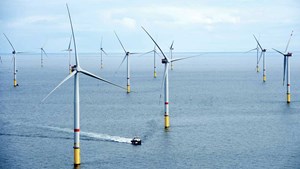Offshore wind makes US debut with East Coast wind farms
(Bloomberg) — After more than a decade of stops, starts and high-profile failures, construction of a massive new U.S. power source meant to displace planet-warming fossil fuels has finally begun at a turbulent time for the industry.
Offshore wind has picked up momentum in recent years. The South Fork project should start generating power in late 2023, which puts it on a similar timeline to the larger Vineyard Wind project off the coast of Massachusetts. And more projects are in the pipeline: Developers have plans for wind farms up and down the U.S. East Coast, generating potentially as much electricity as 40 big nuclear power plants.
But as divers aboard the Jill plunge into the frigid water to work on the sea-to-shore tunnel for the cable that will connect the offshore wind farm 35 miles east of Montauk Point to the onshore electric grid, the industry is gearing up at a chaotic time. Soaring inflation and supply chain woes have forced some of the companies building big new wind farms to delay or even contemplate abandoning their projects.
Two separate developers raised doubts about their big offshore projects in October. New Jersey utility Public Service Enterprise Group Inc. said it was reviewing costs and deciding whether to pull out of Ocean Wind 1, a proposed project in the Atlantic Ocean that would generate 1.1 gigawatts — enough power for 500,000 homes.
Just two weeks earlier, New England utility Avangrid Inc. said its similarly sized Commonwealth Wind project was no longer viable because of higher costs and supply chain woes.
A difficult point for companies building offshore wind farms is they must first lock in prices for the electricity they’ll sell to buyers — often local utilities — and then actually build the project.
If material prices rise after they sign the contracts, that introduces a level of uncertainty that is tough to handicap, said RJ Arsenault, a managing director at FTI Consulting who advises offshore wind developers.
“It’s definitely had growing pains and those will continue,” he said. “It remains to be seen to what magnitude offshore wind becomes a vibrant market in the U.S.”
Clean energy research firm BNEF forecasts that U.S. offshore wind capacity will grow to almost 55 gigawatts by 2035, supplying an amount of power equivalent to 6% of the nation’s generation today.
“Since the U.S. offshore wind industry is so young, the supply chain for turbines and other materials basically doesn’t exist yet”, said Troy Patton, Orsted’s head of program execution in the Americas. “For a while, we’re going to be dependent on European suppliers,” said Patton, who served on a U.S. Navy nuclear submarine before working on offshore wind in Europe.
But a U.S. supply chain is developing, and Orsted and Eversource gave it a boost in 2019 when they committed to buying the underwater cables for their Northeast projects from a South Carolina factory.
Orsted alone has a slate of six offshore wind projects it plans to build off the U.S. East Coast by 2029. The company is building three of those with Eversource and the total cost of those wind farms is about $10 billion — and they’re not the only ones.
Developers spent a record $4.4 billion in February just for the rights to install wind turbines off the New York and New Jersey coast in a blockbuster auction that underscored the surging enthusiasm for carbon-free electricity. And an auction for the rights to build floating turbines in the deeper waters off California drew almost $800 million, the second largest ever in the U.S., with foreign developers dominating the winning bids.
The wind farm faced opposition from fishermen and some locals, who sued because they didn’t want new underground cables in their town. However, the project got the go-ahead after the developers agreed to compromises like installing 12 turbines instead of 15.



